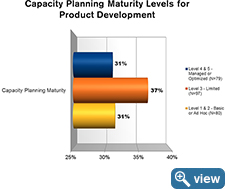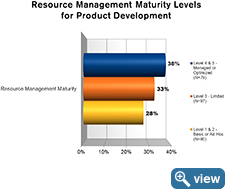
My favorite part of wrapping up a research project is sharing the study’s findings and helping the audience put them to practical use. As the lead researcher in the latest benchmark study, I’ve analyzed two spicy topics facing most product development organizations: capacity planning and resource management. Learn from The Resource Management and Capacity Planning Maturity Matrix and Report Findings—Part 1.
Resource management is the process of using a company’s most precious resources in the most efficient way.
Capacity planning is the process of determining the production capacity needed by an organization to meet changing demands for its products now and in the future.
Background on the Study
Commissioned by Planview and conducted by Appleseed Partners, the research features an impressive global response from more than 600 executives from large product and project-based organizations. More than 280 of your peers in product development shared the state of their organization’s capacity planning and resource management and the impact it has on their business.
The Maturity Matrix
As part of the research, an objective Maturity Matrix was created that allowed participants to benchmark their capacity planning and resource management performance (in terms of people, process, and technology) allowing us to look at their top business risks and pain points by maturity.
In terms of their maturity, product development participants were split fairly evenly into thirds:
- A third identified as Basic or Ad-hoc in maturity, which is characterized as chaotic with very limited visibility into resources and demand
- More than a third said they were in a Limited maturity phase with some visibility into resources but with limitations; and
- A third claimed to have broken through to a higher Managed or Optimized state of maturity with mature work and activity planning processes, the ability to apply resources to the highest value products, and ability to adapt to change
Moving up in Maturity Matrix equals important reductions to business risks and the opportunity for streamlined and accurate resource forecasting and capacity planning.
The research indicates that mature organizations that address resource management and capacity planning have better processes, use the right enterprise software, and employ best practices also experience the following:
- 27% better off in visibility into capacity
- 22% improved visibility into demand
- More than 10% reduction in the risk of delayed time to market resulting in lost revenue, savings, user/customer satisfaction, and/or market share
- 10% lower risk of relying on inaccurate data for decision making
- and more
Making an investment to improve these areas in a product development organization is well worth the effort. The question that stymies some groups is the how to do it, and where to start.
In the upcoming blog series, I will share six characteristics of mature organizations and pragmatic recommendations that will help your organization move up the maturity scale. For a detailed look at the Maturity Matrix, or to find out where your organization ranks, download the report.
Do you have specific questions pertaining to the study? I will be available to answer your questions at the PIPELINE 2013 Mini Conference June 19, register today.
Sample Report Charts
Capacity Planning Maturity Levels for Product Development
| Level 4 & 5 – Managed or Optimized (N=79) | Level 3 – Limited (N=97) | Level 1 & 2 – Basic or Ad Hoc (N=80) | |
|---|---|---|---|
| Capacity Planning Maturity | 31% | 37% | 31% |
Resource Management Maturity Levels for Product Development
| Level 4 & 5 – Managed or Optimized (N=79) | Level 3 – Limited (N=97) | Level 1 & 2 – Basic or Ad Hoc (N=80) | |
|---|---|---|---|
| Resource Management Maturity | 38% | 33% | 28% |




![Product Portfolio Management in the Digital Era [Webinar]](https://blog.planview.com/wp-content/uploads/2017/09/Product-Portfolio-Management-in-the-Digital-Era-750x400.jpg)

